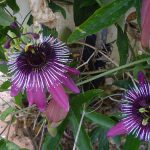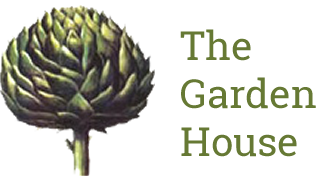Flower of the month: Passiflora (the passion flower)
Posted:14 August 2011
At this time of year, hardy Passiflora are in full bloom. A wonderfully exotic-looking plant, the Blue Passion Flower (P. caerulea) has large white flowers and central filaments of purple, blue and white, followed by egg-shaped, orange-yellow fruit, and flowers from July to September. The fruit are edible, but not very tasty and not to be confused with ones you can buy in the supermarkets!
This vigorous, trouble-free climber looks really good in a tropical planting scheme, and will grow best at the base of a sheltered wall in full sun, although they can tolerate some shade. Even the leaves and tendrils look other-worldlly, deeply lobed, dark green and glossy. It is frost hardy but may need some winter protection in cold areas. The eventual height is 10 metres.
The “Passion” in “passion flower” refers to the passion of Jesus in Christian theology. In the 15th and 16th centuries, Spanish Christian missionaries adopted the unique physical structures of this plant, particularly the numbers of its various flower parts, as symbols of the last days of Jesus and especially his crucifixion:
- The pointed tips of the leaves were taken to represent the Holy Lance
- The tendrils represent the whips used in the flagellation of Christ
- The ten petals and sepals represent the ten faithful apostles (excluding St. Peter the denier and Judas Iscariot the betrayer)
- The flowers radial filaments, which can number more than a hundred and vary from flower to flower, represent the crown of thorns
- The chalice-shaped ovary with its receptacle represents a hammer or the Holy Grail
- The 3 stigmas represent the 3 nails and the 5 anthers below them the 5 wounds (four by the nails and one by the lance)
- The blue and white colours of many species flowers represent Heaven and Purity.
 There are many other beautiful passion flowers but many of them need to be protected and are best grown in a glass house or conservatory.
There are many other beautiful passion flowers but many of them need to be protected and are best grown in a glass house or conservatory.
Being easy to grow they require little maintenance, but if you dont want them to reach too high, plant in pots or tubs and let them grow up and cascade over an obelisk.
Choose three to five of the strongest shoots, tying them in to horizontal wires. Once the plant is established, cut back the flowered shoots immediately after flowering to within two or three buds of the permanent framework of the plant. In spring remove dead, misplaced or overcrowded stems.
If you want to find out more about passion flowers, Passiflora: Passionflowers of the World by Torsten Ulmer and John M. MacDougal is a really good read.

